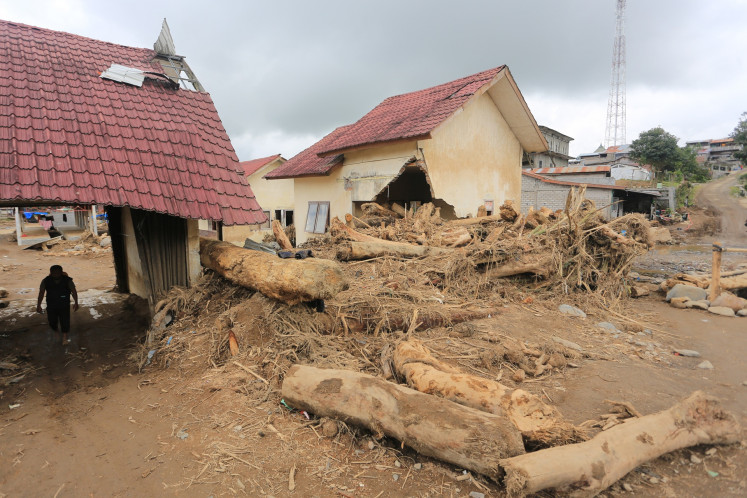Popular Reads
Top Results
Can't find what you're looking for?
View all search resultsPopular Reads
Top Results
Can't find what you're looking for?
View all search resultsHigh alert continues as volcano sickens refugees
The Volcanology and Geological Disaster Mitigation Center (PVMBG) says that the high alert status it imposed on Mt
Change text size
Gift Premium Articles
to Anyone
T
he Volcanology and Geological Disaster Mitigation Center (PVMBG) says that the high alert status it imposed on Mt. Sinabung may be in effect for a long time due to increasing volcanic activities.
PVMBG head Surono said he was not certain if the alert status would be lowered after one or two weeks as data still showed increasing volcanic activity, which could worsen the health of residents.
“My concern is not the refugees, but the volcano. We cannot allow them to go home if the volcano is still on the highest alert status,” Surono told The Jakarta Post on Wednesday.
Surono said he would not risk decreasing the alert status while Mt. Sinabung’s volcanic activity was increasing. “There were several volcanic earthquakes on Sinabung today,” Surono added.
Mt. Sinabung is unique and cannot be compared to other erupting volcanoes, he said.
Scientists previously said the 2,460-meter high volcano was a Type B volcano because it had been inactive for 410 years, but reclassified Mt. Sinabung as a dangerous Type A volcano after the recent eruption.
PVMBG’s volcano handling division head Agus Budianto said that instruments monitoring the volcano showed ongoing internal activities, indicating magma movement deep inside Mt. Sinabung.
“Visually, there is a decrease in activity. Instruments, however, show increasing activity,” Agus said.
He said PVMBG has four levels of alert for volcanoes: normal, waspada (caution), siaga (alert) and awas (danger).
“When a volcano enters the highest status, people living within 6 kilometers must be evacuated,” Agus said.
More than 23,000 people are still living in nearby refugee shelters and many have started to show signs of illness. Medical supplies were sufficient but the open-air camps expose the refugees to illness and disease, an official said.
Some refugees at Jambur Lige, mostly old people and children under 5, have been suffering from respiratory infections, eye diseases and diarrhea, according to reports Wednesday.
“Volcanic ash and cold weather make refugees vulnerable to disease,” said Sirila Tarigan, a paramedic working with the refugees.
Karo Agriculture Agency headNomi Sinuhaji, who is responsible for the Jambur Lige refugees, said that the health of many refugees had been decreasing.
“Sick refugees have been handled well. So far everything is still under control,” Nomi told the Post, Wednesday.
Karo administration officials said 30 refugees were receiving intensive medical care at Kabanjahe hospital. Regency Secretary Makmur Ginting said he was optimistic that the administration could handle the sick refugees well.
“Medical teams and medicine are here. Hopefully everything can be handled well,” said Makmur, adding that the administration has been receiving emergency aid and money to deal with the natural disaster.
The regency has received Rp 1.7 billion in donations: Rp 1.5 billion from the National Disaster Handling Agency and the remainder from the People’s Welfare Ministry, he said.










